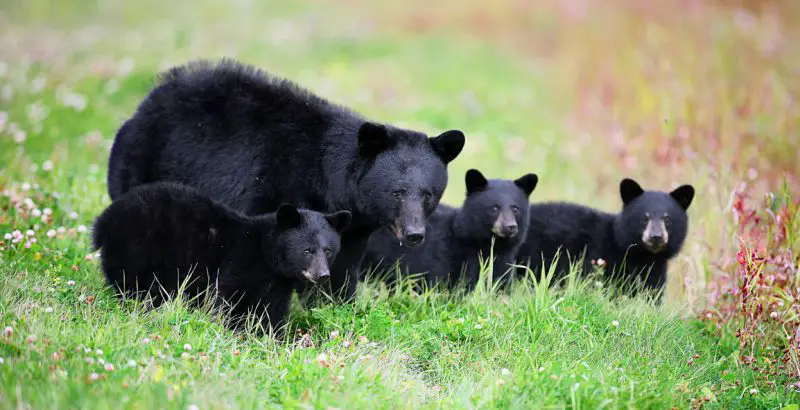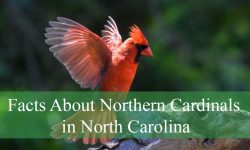Black bears are deeply woven into North Carolina’s natural identity. They move quietly between dense mountain forests, coastal marshes, and recovering Piedmont woodlands, leaving signs that many people overlook—tracks near a creek, a patch of overturned leaves, a tree with claw marks. Although they are among the state’s most recognizable mammals, the true story of black bears is far more complex than occasional sightings suggest.
North Carolina holds one of the strongest black bear populations in the eastern United States. Their survival depends on flexible diets, seasonal movements, and astonishing physical and behavioral adaptations developed over thousands of years. Each region of the state—mountains, Piedmont, and coast—shapes the bears differently, creating unique versions of the same species.
The ten facts below reveal the hidden biology, ecological roles, and survival strategies of black bears in North Carolina that most people never hear about. Taken together, these facts offer a clearer picture of why black bears continue to thrive and expand across the state.
1. North Carolina’s Coastal Plain Produces the Heaviest Black Bears in the Eastern U.S.

The Coastal Plain is famous for producing massive black bears—some of the largest ever recorded in the East. This region provides an ideal combination of long growing seasons, mild winters, and an almost uninterrupted supply of high-calorie foods. Wetlands, pocosins, agricultural fields, and mast-rich woodlands allow bears to forage efficiently without traveling long distances or climbing rugged terrain.
Because these habitats retain moisture and produce edible vegetation throughout most of the year, coastal bears can build fat reserves earlier and maintain them longer. Agricultural crops, especially corn and peanuts, offer easy calories during late summer and fall, helping bears reach exceptional weights well above their mountain-dwelling counterparts.
Mountain bears, by comparison, live under very different energetic demands. They travel steep slopes, climb frequently, and experience seasonal food shortages more sharply. Their bodies are typically leaner and more muscular, reflecting daily movement across rough terrain. This contrast between ecosystems showcases how strongly local environments shape bear physiology and long-term growth.
These regional differences also explain why the Coastal Plain has become a focal point for researchers studying bear nutrition, body condition, genetics, and population dynamics across the Southeast.
2. Black Bears in North Carolina Eat Up to 80% Plants Despite Their Predator Image
Many people assume bears survive primarily by hunting. In reality, up to 80% of a black bear’s diet in North Carolina comes from plant matter. Their daily foraging patterns change constantly with season, temperature, elevation, and habitat type.
Across the state, their diet generally includes:
-
Berries, fruits, nuts, roots, insects, carrion, and seasonal crops
-
Marsh vegetation in coastal regions
Spring brings early greens, grasses, and emerging insects. Summer is dominated by blueberries, blackberries, and other soft fruits, which help bears build energy for the intense feeding months ahead. In fall, acorns and beechnuts become the most important foods, especially in the mountains where hard mast determines whether bears enter winter in strong condition.
Coastal bears have access to additional food sources like marsh plants, persimmons, wild grapes, and farm crops, giving them a steady calorie stream throughout the year. This dietary diversity means bears are constantly adjusting their movements to follow food ripening patterns, often shifting between forest understory, old fields, swamp edges, and agricultural land.
This plant-heavy diet also explains why black bears coexist so closely with human settlements. They follow their noses toward the richest food sources—sometimes leading them near homes, backyards, or areas where waste or pet food is left outside.
3. North Carolina Bears Do Not Truly Hibernate Even at Higher Elevations
Black bears farther north enter deep hibernation for months, but in North Carolina, winter is rarely cold enough to trigger that level of dormancy. Instead, bears enter torpor, a lighter, more flexible form of winter rest. Their breathing slows, their heart rate drops, and their metabolic needs fall dramatically—but they remain capable of waking and moving when conditions allow.
Mountain bears may remain in dens for longer periods because snow cover limits their ability to forage. Even then, they may awaken during warm spells, shift their position, or leave temporarily to search for food. Coastal bears, with far milder winters, may emerge multiple times throughout the season, especially during warm, rainy weather.
This flexible winter strategy reflects how bears balance energy conservation with environmental opportunity. Because they do not fully shut down their systems, they must store enough fat each fall to survive unpredictable weather patterns. Torpor is especially important for pregnant females, who give birth in midwinter when they are at their lowest energy reserves.
Dens vary dramatically across regions. Mountain dens often form in hollow logs, rock crevices, old root systems, or excavated soil. Coastal dens are usually in dense vegetation, ground hollows, or wetland thickets protected by thick cover. Despite this variety, each den provides insulation, concealment, and protection during the most vulnerable part of the year.
4. Cubs Learn to Climb Within Weeks, Making Climbing a Life-Saving Skill
Climbing ability is one of the black bear’s most essential survival tools. Cubs begin climbing within weeks of emerging from the den, often scrambling up nearby trunks while their mother forages. This early skill protects them from coyotes, bobcats, and even adult male bears, which can be a threat to cubs.
Climbing is not limited to young bears. Throughout North Carolina, adult bears climb regularly for food and safety. In the mountains, they ascend beech and oak trees in fall to feed on mast high in the canopy. In summer, they climb fruit-bearing trees for cherries, apples, persimmons, or wild grapes. Coastal bears may climb to escape floods, disturbances, or heat.
Their claws are specially adapted for gripping bark, and their powerful forelimbs support their full weight even on steep or uneven surfaces. Many bears climb with surprising speed, and they often descend headfirst with agility that catches hikers and observers off guard.
Climbing also plays a role in thermoregulation. Bears resting high in trees may catch cooler breezes during hot days or avoid biting insects near the ground. Across the state, climbing remains a versatile, life-saving skill passed down from mother to cub.
5. Black Bears Travel Along Ancient Natural Corridors Still Used Today
Black bears do not move randomly across the landscape. Their travel patterns follow well-established natural corridors shaped by geography, vegetation, topography, and seasonal resources. Many of these pathways are believed to be ancient routes that bears have used for hundreds or even thousands of years.
In the Appalachian region, narrow coves, stream valleys, and long ridgelines act as safe movement routes between feeding areas. These corridors offer thick cover and reliable shade, helping bears travel with minimal exposure. Mountain bears may follow the same drainage or ridgetop year after year, especially during the breeding season.
On the Coastal Plain, bears follow swamp forests, pocosins, and dense wetland thickets where vegetation remains lush even during drought. These environments provide continuous cover and dependable plant resources, making them ideal for travel.
Modern research using GPS collars confirms that bears repeatedly use the same paths across seasons. These ancient corridors now intersect with highways, farms, and developed areas, which creates challenges for bear movement and increases the importance of wildlife crossings, protected riparian zones, and forest connectivity.
6. Bears Accidentally Replant Forests Through Seed Dispersal and Soil Disturbance
Many people do not realize how profoundly black bears influence forest regeneration. As they feed on fruits and berries, they transport seeds across long distances and deposit them in nutrient-rich scat, which greatly increases germination success. Bears often move seeds farther than small mammals or birds, helping maintain plant diversity across fragmented landscapes.
Their foraging behavior also disturbs soil in subtle but important ways. As bears dig for roots, insects, or larvae, they create small pockets of exposed soil that allow certain plants to sprout more easily. These micro-disturbances are vital in heavily shaded forests, where seedlings struggle to emerge without occasional openings.
Bear scat enriches forest floors with nitrogen and organic matter, feeding insects and microbes that break down leaf litter. In coastal ecosystems, bears influence the structure of wetlands by feeding on shrubs, fruits, and marsh plants, indirectly shaping the plant composition of these habitats.
This combination of seed dispersal, soil disturbance, and nutrient recycling makes black bears an underappreciated driver of forest renewal in North Carolina.
7. Black Bears Can Run 30 mph and Outclimb Most Predators Despite Their Size
Black bears are often perceived as slow or lumbering, but they are remarkably fast and agile. They can sprint short distances at speeds reaching 30 miles per hour—fast enough to outrun any human and even many predators. This speed helps them escape threats, chase off rivals, or reach food sources quickly during competitive seasons.
Their strength is equally impressive. Bears can break open logs with a single swipe, dig large holes for dens, and overturn rocks in search of insects. Their muscular limbs support their climbing ability, allowing them to ascend trees far more quickly than most predators can follow.
Young bears demonstrate agility early, learning to run, climb, swim, and balance on uneven terrain within their first months of life. Their athleticism is essential in the mountains, where they navigate steep slopes, dense rhododendron thickets, and rocky outcrops daily.
Even coastal bears rely on these abilities to move through swamp forests, cross fallen logs, and climb above floodwaters. Despite their heavy appearance, black bears are among the most athletic mammals in North Carolina’s wildlife community.
8. Bears Communicate Through a Complex System of Scents, Sounds, and Body Signals
Communication among black bears is far more sophisticated than most people realize. Scent is their primary language. Bears rub against trees, claw bark, or leave scent trails to signal occupancy, reproductive status, or territorial boundaries. These scent posts help individuals avoid conflict and identify nearby bears without direct encounters.
Vocal communication is subtle but meaningful. Bears may snort when startled, huff in warning, grind their teeth during agitation, or emit soft grunts during peaceful interactions. Cubs produce loud bawls when separated from their mothers, prompting immediate responses.
Body language fills in the rest of their communication. Ear position, posture, and head movements reveal whether a bear is stressed, curious, or preparing to retreat. These signals are essential in areas where bears frequently overlap territories, especially during the breeding season.
This complex communication system helps black bears maintain order across large landscapes, reducing unnecessary fights and supporting social structure within populations.
9. Black Bears Are Rapidly Expanding Into New Regions of North Carolina
Black bear populations are growing, and with that growth comes geographic expansion, especially into parts of the Piedmont where bears were historically rare. This expansion reflects improved habitat quality and decades of conservation success.
Several factors contribute to this expansion:
-
Successful conservation policies
-
Abundant food sources
-
Increased forest cover in once-cleared farmland
-
Natural population growth
-
Wildlife corridors that connect habitats
Juvenile males are usually the first to explore new territory. During late spring and early summer, they may travel dozens of miles in search of suitable habitat, often venturing into suburban edges or new forest corridors. As landscapes mature and forests recover from historical clearing, these regions now offer cover and food that meet bear needs.
This expansion emphasizes the importance of coexistence strategies—proper waste management, secure food sources, and understanding bear behavior—to reduce conflict while allowing bears to occupy suitable habitats naturally.
10. Mother Bears Give Birth in Midwinter While in a State of Torpor
One of the most extraordinary facts about black bears is their reproductive strategy. Pregnant females give birth in midwinter while in torpor, a stage when their bodies operate at the lowest metabolic levels of the year. Despite giving birth during this low-energy state, female bears produce extremely rich milk that supports rapid cub growth.
Newborn cubs are unbelievably small—blind, hairless, and weighing less than a pound. In the safety of the den, they grow quickly as their mother dozes, rouses intermittently, and maintains warmth. By early spring, they are several pounds heavier and ready to explore the world outside.
Den sites vary dramatically across the state. Mountain bears use rock crevices, root systems, or hollow logs, while coastal bears often nest in dense vegetation or excavated earth surrounded by thickets. Regardless of the location, dens offer insulation, security, and concealment during the critical early months of cub development.
This winter birth strategy helps protect cubs from predators, harsh weather, and the dangers of the outside world, giving them a strong start during the most vulnerable stage of life.
Frequently Asked Questions About Black Bears In North Carolina
Are black bears common in North Carolina?
Yes. Populations are strongest in the mountains and coastal regions and continue expanding into the Piedmont.
Do black bears hibernate?
They enter torpor—a lighter, flexible form of winter dormancy—but may wake during warm spells.
Are black bears dangerous?
They avoid confrontation. Most negative encounters happen when bears access human food sources.
What should I do if I see a bear?
Give it space, remain calm, and ensure you do not approach or feed it.
Why do bears enter neighborhoods?
They are attracted to unsecured garbage, outdoor pet food, bird feeders, and food scents from backyards.
How long do black bears live?
Wild bears commonly live 15–20 years, with some individuals surviving longer.
Can bears climb?
Yes. Black bears are excellent climbers and rely on trees for safety and feeding.
What time of year are bears most active?
Spring through fall shows the highest activity as bears forage heavily to build fat reserves.
Final Thoughts
Black bears are far more than occasional sightings along trails or roadsides. Their influence stretches across ecosystems—from dispersing seeds to shaping plant communities and navigating seasonal movements that reflect the health of North Carolina’s landscapes. Understanding how these animals live, communicate, and adapt offers a deeper appreciation for the wilderness surrounding both rural and suburban communities.
Whether watching a bear cross a mountain ridge at dusk or seeing tracks along a riverbank, each encounter reminds us that wildlife continues to thrive in the southeastern forests. Coexistence begins with awareness, and by understanding black bears, we support a richer, more balanced natural world.






